| |
On
the preceding page we introduced the concepts of two "evolutionary
forms" of Marsh Wren — Eastern and Pacific — and that of three "field
identifiable" Groups. There is just one Group in the Eastern form, but
two Groups in the Western form: Pacific and Interior West. We also
discussed vocal identification, the existence of an identifiable
juvenal plumage, and the effects of wear on adults. We will now look at
the various Groups of Marsh Wren in more detail. Some generalized maps
are presented, but the lines between subspecies are very approximate
and were drawn using only summaries in the literature (primarily
Kroodsma & Verner 1997). These borders are not exact and should not be relied upon to assign birds near boundaries
to a particular subspecies. Indeed, there is often a broad 'merger'
zone at the boundaries of subspecies where one race gradates into
another. |
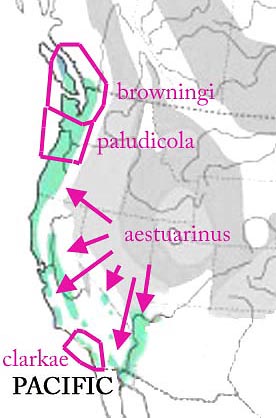 |
The Pacific Group has four subspecies:
- browningi
is mostly resident from coastal sw British Columbia to west-central
Washington; apparently some movement southwards in northernmost
populations to sw Washington.
- paludicola is apparently resident from sw Washington to west-central Oregon. Pyle (1997) and older texts considered paludicola to be the coastal resident race all the way to San Diego, California, but Unitt et al. (1996) found no specimens of paludicola south of Lincoln Co., Oregon, nor did they report any evidence of migration.
- aestuarinus
has an extensive but patchy range along the Pacific coast from s Oregon
to Ventura Co., California, and eastward through the San Francisco Bay
area and Central Valley, and southeast through the California deserts
to the Salton Sea and Colorado River, with local breeding occurrence
northwards into s Nevada and in Death Valley NP, California (per Unitt
et al. 1996). Pyle (1997) and other texts had restricted aestuarinus to just the Central Valley and had recognized a desert race called 'deserticola' in south-eastern California and along the Colorado River. Unitt et al. (1996) merged 'deserticola' into aestuarinus,
finding that the subspecies was only diagnosable at the sites at which
it was originally named, but that intergradation between them was
complete. Unitt et al. (1996) found little evidence of migration in aestuarinus
and although there is some short-distance post-juvenal dispersing
locally, they considered the subspecies to be resident. Pyle (1997) had
thought there was some migration from the Central Valley to the coast.
There is certainly some movement because Marsh Wrens appear throughout
much of California in fall and winter at locations at which they do not
breed.
- clarkae is resident in
coastal southern California from Los Angeles Co. to San Diego Co., and
inland to w Riverside Co. This subspecies was named by Unitt et al.
(1996) and was not referenced at all in Pyle (1997), who considered it
a part of paludicola.
|
|
 |
Based on range, this is probably browningi, although it is at a spot in central-west Washington state that may be nearing the border with paludicola. The April bird is in more worn plumage than the paludicola in December (photo just below) but browningi
is described as having "flanks brownish" rather than "medium brown with
a rufous to dark rufous tinge" (Pyle 1997), so it should look duller
than paludicola in most plumages, I guess — and certainly looks duller than either photo of paludicola (next photos below).
photo (left) 10 Mar 2010 Chehalis Wildlife Area, west of Alma, Grays Harbor Co., WA © Dennis Paulson |
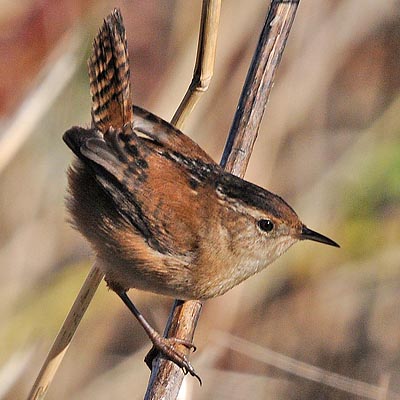 |
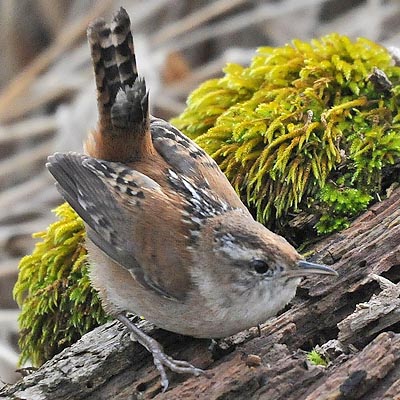
Based on range, these are paludicola.
The December photo (at far left) shows a bird in new, crisply-colored
plumage; the April photo (near left) shows a more worn bird than is
plainer in appearance.
photo (far left) 30 Dec 2012 Ridgefield NWR, Clark Co., WA © Dennis Paulson
photo (near left) 3 Apr 2011 Ridgefield NWR, Clark Co., WA © Dennis Paulson |
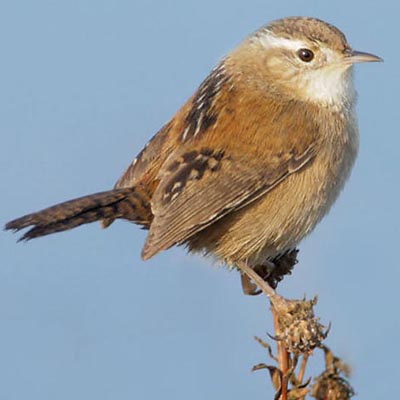 |

These are aestuarinus —
the widespread California subspecies west of the Sierra and in the
Mojave Desert. The December bird (far left) is crisp and bright; the
Feb songster (near left) is a bit less so. This race is generally
considered to be bright and colorful, and the birds do have extensively
brown crowns.
photo (far left) 11 Dec 2008 Arrowhead Marsh, Oakland, Alameda Co. CA © Tom Grey
photo (near left) 3 Feb 2007 Merced NWR, MER, CA © Tom Grey |
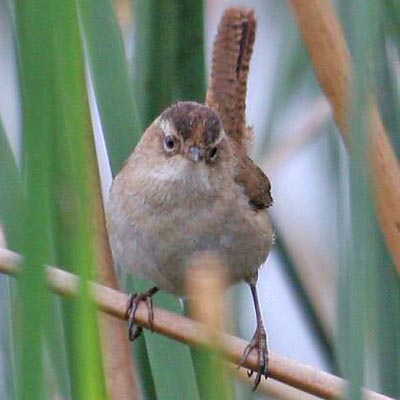 |
Based on range, this is clarkae,
the recently described subspecies in coastal southern California
marshes from Los Angeles to San Diego Counties. It differs from aestuarinus primarily
in an extensively blackish crown (brown limited to forecrown); see
Unitt et al. (1996). This March photo would be of a spring bird that
was getting somewhat worn.
photo (left) 8 Mar 2007 San Joaquin Wildlife Area, Orange Co., CA © William Hull |
|
| Pacific
Marsh Wrens can be described as medium-to-small in size; more colorful
and contrasty than Interior West birds; generally show quite a bit of
rufous on rump and shoulders, and often on flanks. The crowns is mostly
brown with blackish edges to the sides of crown (except in sw
California coastal marshes that are primarily black-crowned). Migration
in the Group is apparently limited to post-breeding dispersal and
short-distance migration from colder areas, perhaps toward the coast. |
| |
 |
The Interior West Group has three subspecies:
- pulverius
from c British Columbia and south across much of the Great Basin, south
to eastern California and Nevada, and including western Montana;
winters to sw U.S., w Texas.
- plesius from se Idaho and w Wyoming through Utah, Colorado, and western Nebraska; winters from Kansas to Texas.
- laingi
has a large range in central Canada east of the Rockies and south to ne
Montana, much of North Dakota, and to c South Dakota; winters to New
Mexico, Texas. This subspecies apparently intergrade with "eastern"
Marsh Wrens in a broad swathe in the central prairies (as detailed on
the previous page).
|
|
 |
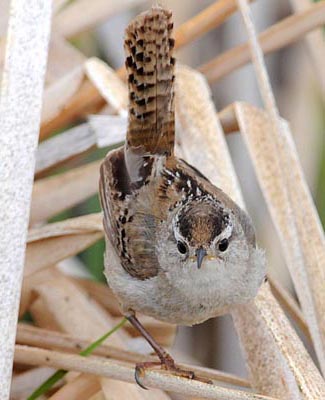
On range, these are pulverius,
which is a medium large subspecies whose back in mostly "pale brown
with little or no rufous," and with "pale brownish" flanks (Pyle 1997).
Even though both of these photos are of somewhat worn birds in spring
(particularly the photo from May), it is apparent that these are rather
drab and plain brown birds when compared to populations on the east or
west coast of North America.
photo (far left) 24 May 2009 Sanger Lake, Okanogan Co., WA © Dennis Paulson
photo (near left) 3 Apr 2011 near Burns, Harney Co., OR © Netta Smith |
 |
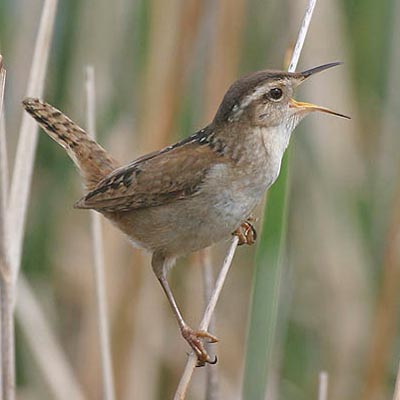
On range, these are plesius,
from Utah and Colorado, and both photos are rather late in the season
so the birds are worn. They look large, pale, and brown. Pyle (1997)
states that fresh birds have a "rufous tinge" to rump, perhaps still
slightly present in the Colorado photo.
photo (far left) 16 June 2001 Bear River NWR, UT © Greg W. Lasley
photo (near left) 19 May 2004 Weld Co., CO © Tony Leukering |
 |

On range, these are laingi,
and both photos were taken in summer on the same date, so the bird(s)
are worn. Although these wrens are still "brown," it is apparent that
this race is more colorful and contrasty than either of the Great Basin
races. Pyle (1997) describes "cinnamon rump" and "brightish pale
cinnamon flanks" for this race, and those characters are still somewhat
evident, even in these summer photos. I also see darker and more
contrasty crown on these birds.
both photo (left) 21 June 2010 Minot, north-central North Dakota © Brian L. Sullivan |
|
| Interior West
Marsh Wrens can be described as medium-to-large in size; generally pale
and quite plain-brown compared to either Pacific or Eastern birds. They
tend to show rather limited rufous on rump and flanks (if at all), and
tend to have pale-brown shoulders. The crown is mostly brown with
blackish edges to the sides of crown. Many populations are
long-distance migrants and could be expected as vagrants from
California to the eastern U.S. Unfortunately, migrants and wintering
birds of all populations of Marsh Wren tend to be skulkers, and do not
sit up out in the open very often. |
| |
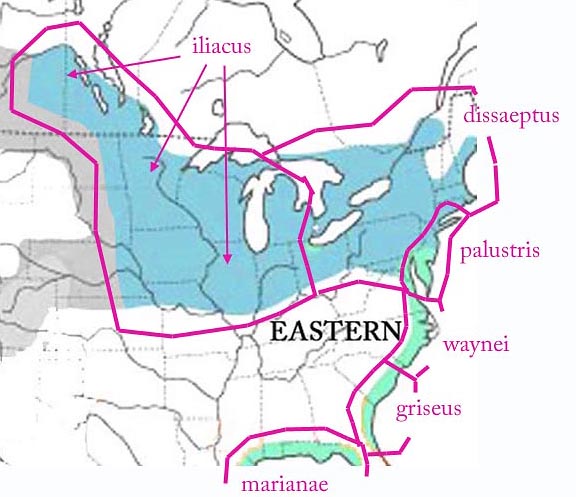 |
The Eastern Group has six subspecies:
- iliacus
from e Saskatchewan and central Manitoba south to the Midwest, taking
in the easternmost portions of the Dakotas and Nebraska, and east to
Michigan and e Ohio; winters to the Gulf Coast of se U.S. This
subspecies apparently intergrades with "western" Marsh Wrens in a broad
swathe in the central prairies (detailed on the previous page).
- dissaeptus of the Northeast, from Ontario and c Ohio east to Maine and Massachusetts; winters to the Gulf Coast of se U.S.
- palustris is the nominate race, mostly resident in coastal New York, New Jersey and east-central Virginia.
- waynei is resident from coastal se Virginia through coastal North Carolina.
- griseus is resident from coastal South Carolina to east-central Florida, and
- marianae is resident of the Gulf Coast from east Texas to west Florida.
These
subspecies are described in Pyle (1997) and Kroodsma & Verner
(1997). This internet project is summarized by a California observer,
primarily for use by western birders, and I have neither the resources
(i.e., a good set of photos of all races) nor the expertise to discuss
regional variation in the Eastern populations.
However, for comparison with western populations, the northeastern race is discussed below. |
|
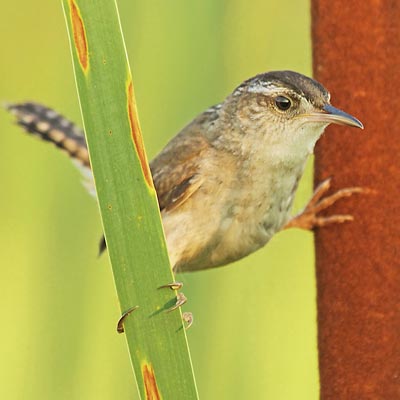 |

On range, these are dissaeptus,
and both photos were taken in summer on the same date, so the bird(s)
are worn. Although these wrens are still "brown," it is apparent that
this race is more colorful and contrasty than either of the Great Basin
races. Pyle (1997) describes "cinnamon rump" and "brightish pale
cinnamon flanks" for this race, and those characters are still somewhat
evident even in these summer photos. I also see darker and more
contrasty crowns on these birds.
photo (far left) 11 July 12 Great Meadows NWR, MA © Ryan Schain
photo (near left) 29 May 2011 Great Meadows NWR, MA © Ryan Schain |
|
|
| Eastern
Marsh Wrens can be described as medium-to-small in size; more colorful
and contrasty than Interior West birds; generally show a lot of rufous
on rump, tails, shoulders, and flanks. The crown is mostly blackish,
contrasting with a white supercilium, but on close views can show a
central brown stripe to forecrown. In short, they look a lot like
Pacific Group wrens but average somewhat more colorful and contrasting,
with blacker-appearing crowns. They are best separated by song. Many
are long-distance migrants and vagrants could be expected but whether
one would be recognizable as a vagrant is uncertain. |
|
|
| |
Photos:
All photos © Don Roberson, except those attributed to © Mark
Eaton, Tom Grey, W. Ed Harper, Sacha Heath, William Hull, Greg W.
Lasley, Tony Leukering, Dennis Paulson, Netta Smith, Ryan Schain, Dan
Singer, and Brian Sullivan, used with permission; all rights reserved.
Many thanks for Dan Singer's comments on an earlier draft.
Literature cited:
Kroodsma,
D.E. 1989. Two North American song populations of the Marsh Wren reach
distributional limits in the central Great Plains. Condor 91: 332-340.
Kroodsma, D.E., and J. Verner. 1987. Use of song repertories among Marsh Wren populations. Auk 104: 63-72.
Kroodsma, D.E. and J. Verner. 1997. Marsh Wren (Cistothorus palustris) in The Birds of North America Online (A. Poole, Ed.). Cornell Lab of Ornithology, Ithaca.
Leukering, T., and N. Pieplow. 2010. Eastern and Western Marsh Wrens. Colorado Birds 44: 61-66.
Pyle, P. 1997. Identification Guide to North American Birds, Part I. Slate Creek Press, Bolinas, CA.
Roberson, D. 2002. Monterey Birds, 2d ed. Monterey Pen. Audubon Soc., Carmel, CA.
Unitt,
P., K. Messer, and M. Théry. 1996. Taxonomy of the Marsh Wren in
southern California. Proc. San Diego Soc. Nat. Hist., No. 31.
|
|
|

















